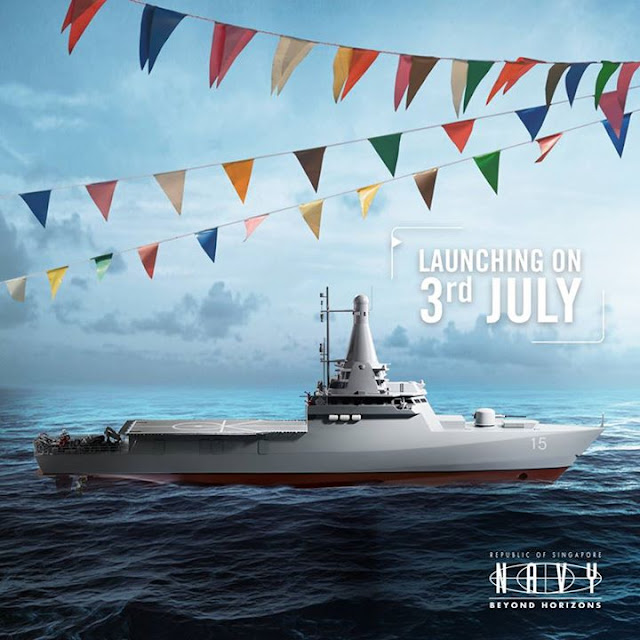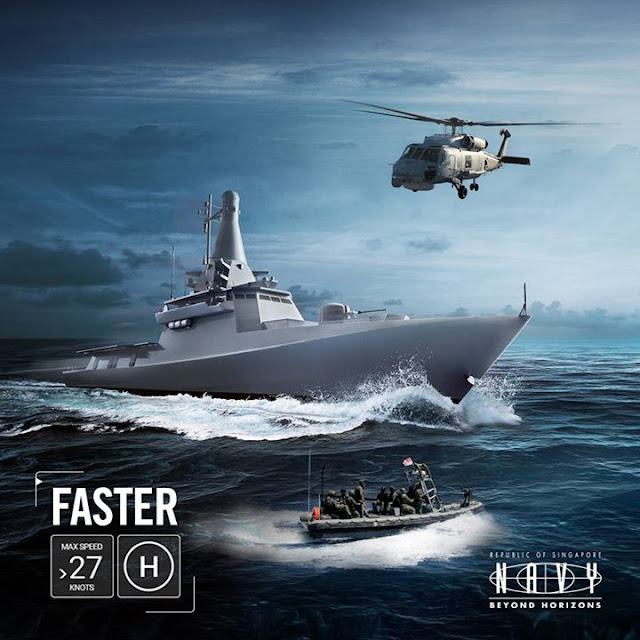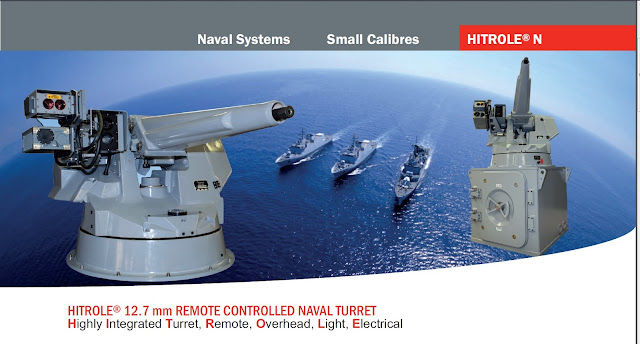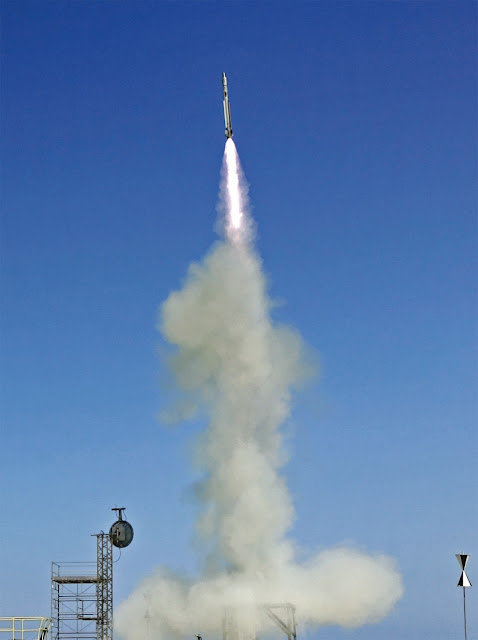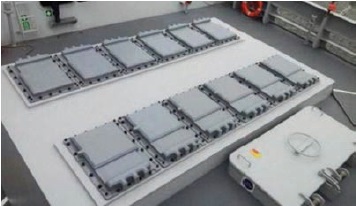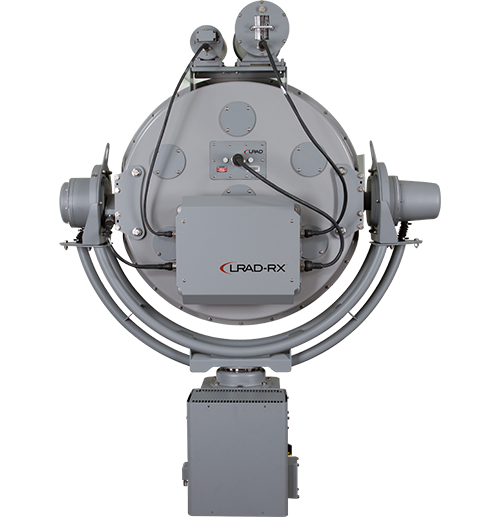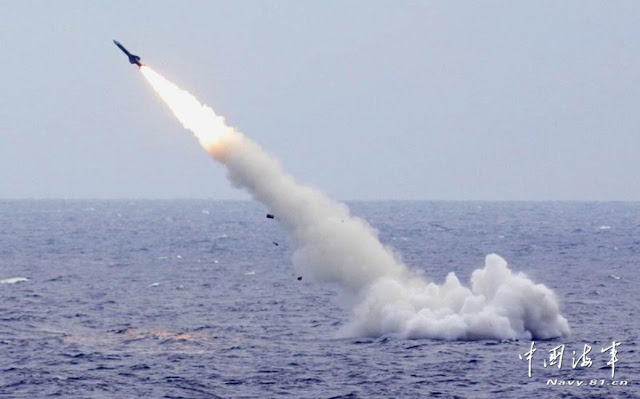Most Tenacious Fighter
 |
| Profile view of a RMAF MiG-29N in a photo taken in 2014. Source Wikipaedia. |
The Royal Malaysian Air Force ( RMAF ) MiG-29N ( NATO reporting name Fulcrum ) has to be the most tenacious fighter in recent memory, not in a dog fight as most might imagine, turning Gs and doggedly pursuing the enemy fighter trying to get missile-lock, but in its uncanny ability to evade relegation to the scrapyard time and again. The Fulcrums were delivered in 1995. In 2009, the Malaysians announced that the MiGs were to be decommissioned in 2010, but it did not happen. The Fulcrums soldiered on and were given another five years till 2015. Well we are currently approaching 4Q2015 and the Fulcrums are still around! The multirole combat aircraft ( MRCA ) project to replace the MiGs had stalled, and there are talks about upgrading the fleet to extend their service life to 2020 and beyond!
Malaysia's Love Affair With Soviet / Russian Weapons
Way back in 1994, not long after the Cold War ended, Malaysia, then under the leadership of Prime Minister Mahathir, placed an order for 18 MiG-29N jet fighters from Russia. That purportedly was to fill " a glaring gap in our need for an air superiority fighter ", in the words of the then Minister for Defence Najib Razak ( now Prime Minister ). A gap, real or perceived, that was getting increasingly bigger as their tiny neighbour Singapore acquired several tranches of fairly advance F-16 fighters from America beginning from 1988.
It was a highly unusual and controversial move, since Malaysia had all along been accustomed to fielding weapon systems from the West and in particular from the United States, examples of which included the Northrop Grumman F-5E Tiger and the Douglas A-4PTM Skyhawk. Prior to 1991, the MiG-29 was only made available to countries that were part of the Soviet bloc or else had good ties with Moscow, like India and North Korea.
The MiG-29 was selected from a shortlist of fighter jets that included the Lockheed Martin F-16, the Boeing F-18, the Dassault Mirage 2000 and the Dassault Rafale. It was supposedly chosen mainly for its low flyaway cost, which analysts say can be one third to one half less than its American or European counterparts. The Malaysians also seemed to believe that the MiG-29 was the most capable and versatile fighter that was available to them at that point of time.
Another factor swinging to the MiG-29's favour was that Yeltsin was only too happy to barter the Russian jets for Malaysian commodities like palm oil and durians, thereby further reducing the amount of cold hard cash that Mahathir had to cough out for the deal. The Russians also promised fast delivery starting from 1995 with new builds and not refurbished or upgraded Soviet surpluses.
Despite warnings from critics that the MiG-29 could prove expensive to operate in the long run, Malaysia went ahead to equip its air force with the Fulcrums anyway. I am not certain if the top brass had any concept of total cost of ownership and of maintenance and service contracts, but lo and behold, the critics got it right and the MiGs did turn out to be expensive and difficult to maintain.
Cheap To Own, Expensive To Use
Part of the reason why the MiGs were expensive and difficult to maintain was that Russian equipment were generally not made to match the high standards of their western counterparts. They are generally simple to operate and rugged to allow for operations under austere conditions but are certainly not made to last. They are relatively cheap to produce in large quantities so if any were to break down, they can be easily replaced rather than repaired. According to Mark Bobbi of IHS, during the Cold War, the Soviet Union's massive defense spending resulted in and allowed for hugely wasteful procurement practices where by aircraft manufacturers such as Mikoyan Gurevich and Sukhoi would design so called " throwaway aircrafts ", expected to operate for ten years or so with little or no maintenance before they were scrapped and replaced with all new aircrafts. So if you are trying to get some Russian or legacy Soviet equipment repaired, be ready to face some real hurdles.
The quality of service and support from Russia is also simply not at the same level as those from Western companies like Boeing or Dassault. Apart from the language barrier, the work culture is entirely different. Business ethics may be non-existent, as the Russian supply chain is notoriously known to be the most inefficient and corrupt.
To make matters worse, the Malaysians themselves imposed restrictions as to who could supply parts and carry out maintenance works on their aircrafts. It seemed that only companies majority owned by indigenous people could qualify and they of course seized the opportunity to inflate prices, since there was little transparency and almost no competition. In the end, each Fulcrum would cost $5 million to service annually, and that's in US Dollars, not the Malaysian Riggit which in recent times had fallen to historical lows.
To Decommission Or Not To Decommission
By 2009, barely 14 years after initial Fulcrum deliveries, the Malaysians have had enough of the maintenance nonsense and was actively looking forward to retire them. Two had already crashed, one in 1998 and the another in 2008. At the 2009 Langkawi International Maritime and Aerospace Exhibition ( LIMA 2009 ), then Minister for Defence Ahmad Zahid Hamidi had reportedly said that the ministry would phase out the MiG-29 in 2010 and replace it with a more capable multirole combat aircraft. It was estimated that USD 75 million could be saved annually by phasing out the MiGs and that the money could be better spent on servicing the other aircrafts in the inventory of the RMAF.
However, barely a year later, typical of the flip-flop decision making process of Malaysian politicians, the very same Minister announced that the RMAF would continue to fly 10 out of the 16 remaining Fulcrums until 2015. This is despite the fact that, in his words, the MiGs and their weapon systems had gone past their expected operational lifespan of 10 years. So the most flyable ones would be selected and the operational tempo would be reduced to allow them to last until 2015.
In the mean time, Malaysia had initiated a MRCA competition for 18 aircrafts with another 18 as option and eventually shortlisted the French Rafale, the Swedish JAS-39 Gripen, European Typhoon and the American F/A-18 Super Hornet. The Russian Su-30 did not make it to the final listing for reasons not immediately apparent, since Malaysia already has 18 Su-30MKM advanced Flanker-H variants in operation from 2007.
The problem was, they did not give themselves a firm deadline for the final decision and have still not made up their minds. All that while, the fiscal and political situation deteriorated with falling oil and commodity prices, depreciation of the Ringgit, the withdrawal of popular food and petrol subsidies and the increase in consumption tax, making the decision to buy expensive fighter jets hard to swallow with voters. Negotiations with the aircraft manufacturers soon turned from an initial out right purchase to leasing options. Then, all of a sudden, on 1st Jun 2015 during the 57th anniversary ceremony of the RMAF at Kuantan ( where the MiG-29N squadron is based ) the air force chief announced that the MiG-29 may not be retired after all! They could be upgraded perhaps to the latest MiG-29 SMT standard or equivalent and fly till the year 2020 or beyond! The entire MiG-29 replacement programme is beginning to look like a circus complete with clowns which only the just cancelled Indian M-MRCA programme could beat.
The Mikoyan MiG-29 Fulcrum
Before we go into details of the proposed upgrading of Malaysia's MiG-29N, let us first take a closer look at the original Cold War relic itself.
 |
| Serbian MiG-29 carrying R-60 ( AA-8 Aphid ) air-to-air missiles. Wikipedia |
| German Air Force MiG-29 on its last US Tour. USAF |
The MiG-29 Fulcrum is a twin-engine, single seat fighter produced in land-based and carrier-capable variants. It was the product of the Soviet aircraft company Mikoyan Design Bureau which has a long history dating back to World War II. They produced many of the iconic post war fighter designs used by the Soviets and their affiliates, including the MiG-15 which was active during the Korean War, the MiG-17 and MiG-19 during the Vietnam War, and the MiG-21 during the Middle-Eastern Wars.
It was conceptualized in the seventies as an air superiority fighter in response to the emergence of the new American " Teen Series " fighters, the McDonnell Douglas F-15 ( Now Boeing ) and the General Dynamics F-16 ( Now Lockheed Martin ).
 |
| The uninspiring MiG-17 restored with Polish Air Force markings. Wikipedia |
While their earlier designs were esthetically uninspiring and probably aerodynamically poor - the MiG-15 and 17 do resemble flying cylinders with wings stuck onto them and the cockpit added as an after thought - the MiG-29 is rather different and much more elegant in shape and form. For the first time ever, the Soviet design is actually streamlined and beautiful and doesn't hurt the eyes to look at. When western intelligence first saw the pictures of the MiG-29 in 1977 around the time of its first flight, they realized that the Soviets had finally caught up in aeronautical technology and that they might be looking at a formidable fighter.
 |
| Peruvian MiG-29 in a near vertical climb. Source RAC MiG |
Introduced into service with the Soviets in 1983, it wasn't until 1986 that the MiG-29 was first publicly seen in the West when it was displayed in Finland. Then, the Soviets were trying to sell it to the Finns. It subsequently went on display in 1988 at the Farnborough Airshow and even conducted flying displays at the 1989 Paris Airshow. Here are some of the vital statistics of the baseline Fulcrum :
Length : 17.37m
Wingspan : 11.40m
Empty Weight : 11000kg
Maximum Takeoff Weight : 20000kg
Engines : 2 x Klimov RD-33 Afterburning Turbofans rated at 8300Kgf each
Fuel Capacity : 3500kg Internal. Additional 900kg in Centreline Drop Tank.
Maximum Speed : Mach 2.25 or 2400km/h at altitude
Range : 1430km with max internal fuel
Combat Radius : 185 to 278km ( 100 - 150 nautical miles )
Service Ceiling : 18013m ( 59100 ft )
Maximum G-Load : 9g ( limited to 4g with centerline fuel tank until empty )
Guns : 1 x 30mm GSh-30-1 cannon with 100 to 150 rounds.
Hard Points : 6 x under-wing pylons, 1 x centerline under fuselage
Weapons : Mix of short range and medium range air-to-air missiles.
including the AA-8 Aphid, AA-10 Alamo and AA-11 Archer
Limited ground attack capability with bombs and rockets.
Avionics : Phazotron N019 Radar
Laser Range Finder
Infra-red Search and Track sensor
Helmet mounted target designator
Secrets of the Fulcrum began to unravel when the German Air Force inherited East Germany's 24 early model MiG-29 upon reunification in 1990. They were almost brand new, having been delivered in 1988 and 1989, and were quickly made NATO-compatible and integrated into the Luftwaffe. Before long, NATO fast jet pilots were conducting dissimilar air combat training ( DACT ) with the Fulcrums, pitting it against F-16s and F-15s. From 1996 some USAF pilots even got to learn to fly the Fulcrum in exchange programmes with the Luftwaffe.
| A Luftwaffe MiG-29 firing a AA-10 Alamo missile at a QF-4 drone. Source : Wikipedia |
It has an incredible turn rate and is extremely agile in a dogfight, more than a match for similar 4th generation American fighters like the F-16 and the F-15.
It is extremely lethal at close range where the use of the helmet-mounted sight with the heat-seeking air-to-air AA-11 Archer missile enables firing at up to 45 degrees off-boresight. This capability was remarkable because the US only managed to catch up in 2003 when the all-aspect AIM-9X Sidewider missile ( said to have a 90 degree off-boresight capability ) and the Joint Helmet-Mounted Cueing System ( JHMCS ) was pressed into service.
The MiG-29 was found to be lacking good avionics with a sub-par fire-control radar, poorly developed Head-Up Display and a knob and switch congested cockpit. All these eventually contributed to limited situational awareness for the pilot. As a result, the Fulcrum pilot has little autonomy and is highly dependent on ground based intercept controllers to vector them during engagements.
The Fulcrums have limited fuel capacity, carrying 3500kg internally and another 900kg in a centerline external tank, no inflight refuelling probe and two thirsty RD-33 engines to feed. This translates to a very small combat radius. According a former Luftwaffe commanding officer of the MiG-29 squadron, the Fulcrum has a combat radius of about 100 to 150 nautical miles.
So in essence, the early export versions of the MiG-29 are of not much use apart from intercepting aircrafts that were near its base.
RMAF's MiG-29N
 |
| A pair of Royal Malaysian Air Force MiG-29N Fulcrum from the now defunct 17 Squadron in close formation. Note the aerial refueling probe below the canopy. Source : RAC MiG |
Malaysia's Fulcrums are designated the MiG-29N and the MiG-29NUB for the two-seater trainer version. They have the baseline Fulcrum-A configurations but had received some upgrade work in 1999 to enhance their fire control radars and allow them to have beyond visual range ( BVR ) missile capabilities. In particular, we are talking about equipping the Fulcrums with the Vympel RVV-AE missile, a.k.a. the Vympel R-77 or AA-12 Adder medium range air-to-air missile. It was a serious game changer at that time as it introduced a new capability to the region. None of the South East Asian air forces had BVR missiles at that time and the United States was reluctant to sell it to anyone least it triggers off an arms race. But Malaysia had to do it first, and the floodgates were opened. Today, almost every regional air force has BVR capabilities. The F-16 and F-15 fighters of the Republic of Singapore Air Force are equipped with the AIM-120C5 and C7 variants. Even RMAF's F/A-18D Hornets have the AIM-120C5.
 |
| The Vympel R-77 BVRAAM aka AA-12 Adder, nick named AMRAAMski by Western journalists seen hare on display at MAKS 2009 in Moscow. Photo : Wikipedia |
Another important part of the upgrade was the addition of a retractable aerial refueling probe on the port side just below the canopy. This can significantly increase the combat radius of the Fulcrum when paired with RMAF's KC-130 tanker. I am not sure if the MiG-29N can buddy refuel each other like what you see below, but getting an aircraft with low fuel capacity to refuel another one with an equally low fuel capacity is probably not the smartest idea except during an emergency.
A quick calculation based on the internal fuel capacity of 3500kg and a gross takeoff weight of 18000kg would yield a fuel-fraction of just 0.194. And I thought the F/A-18 Hornet was bad at 0.23. The norm is between 0.30 to 0.35. No wonder we rarely see operational Fulcrums flying without their underbelly tanks and sometimes even under-wing tanks.
Initially equipping two squadrons, 17 and 19 at Sultan Ahmad Shah Air Base in Kuantan on the East coast of Peninsular Malaysia, all assets are now merged under the banner of 19 Squadron, the Cobras. That made sense as the RMAF is estimated to have only about 10 flyable Fulcrums currently, out of the initial 18 procured in 1995.
Proposed Upgrading of The MiG-29N
So far it has been established that the MiG-29 with its many short comings is far from being the most capable 4th generation fighter jet that money can buy. It is inferior in almost every aspect when compared to its bigger cousin the Sukhoi Su-27 Flanker. As a result it did not enjoy as much success as its designers at Mikoyan had hoped for, both domestically as well as internationally. Only a total of about 1600 have been produced. Many of the earlier MiG-29 variants are in urgent need for upgrades to enable them to extend their service life and RAC MiG ( Russian Aircraft Corporation MiG, sometimes also called RSK MiG, the latestest incarnation of the Mikoyan-Gurevich Design Bureau ) is doing a roaring business upgrading those old airframes for Russia and its allies. The MiG-29SMT upgrade for the Russian Air Force converts the baseline Fulcrum into a MRCA by having new radars with air-to-ground capabilities and also comes with improved cockpit displays and ergonomics like HOTAS, digital fly-by-wire controls, engines with higher thrust ratings, conformal fuel tank and aerial refueling probe. India is doing the same to its Fulcrums with the MiG-29UPG variant by Hindustan Aeronautics Limited ( HAL ). In other words, it gives the early generation Fulcrum what it should have had but didn't have.
 |
| The MiG-29SMT is a multi-role combat aircraft with air-to-air and air-to-ground capabilities seen here carrying the AA-12 Adder and the KAB-500Kr Electro-Optical Guided Bomb. Photo : RAC MiG |
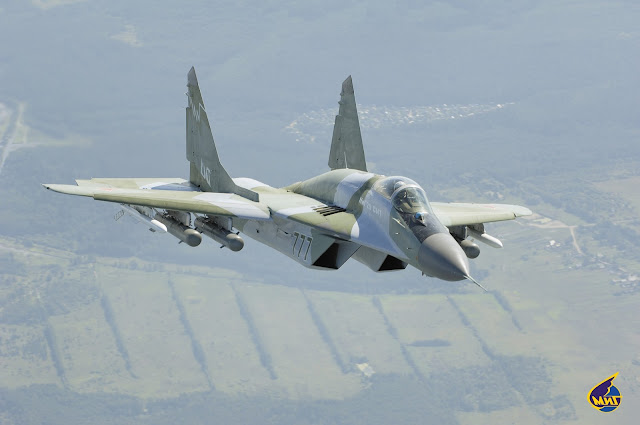 |
| The same Russian MiG-29SMT from a different view. The distinctive dorsal hump is difficult to miss. Photo : RAC MiG |
 |
| Yet another view of the MiG-29SMT. Photo : RAC MiG |
Meanwhile at the LIMA 2015 exhibition, the CEO of Malaysia's Aerospace Technology Systems Corp. (ATSC) Mohd Fadzar Suhada announced that they have an upgrade solution for his country's ageing MiG-29Ns. ATSC was formed in 1994 as part of the original MiG-29N deal with Russia. Its original role was to help in the servicing and maintenance of the Fulcrums but have since been involved with servicing the Su-30MKM Flankers as well. It is a joint venture which is 70% owned by Malaysia and 30% by Russian interests.
The proposed MiG-29N upgrade programme was launched in conjunction with RAC MiG of Russia, the original equipment manufacturer, and is very similar to India's ongoing MiG-29UPG programme meaning it is less risky as it has a proven blueprint to follow. The first MiG-29UPG upgraded in India had just been flight-tested in Feb 2015 and a total of 62 Fulcrums are being upgraded by HAL with the help of RAC MiG. Photos of earlier batches being upgraded in Russia in 2011 can be seen below.
He claimed that the upgrade programme was not an interim solution until the MRCA came along but rather a medium to long term solution to Malaysia's fighter requirements, delivering what the RMAF needed at 20% the cost of buying new.
The upgraded Fulcrums would be known as the MiG-29NM where M stands for Modernized or Modernizirovannyi, depending on which part of the world you come from. They will incorporate the Phazotron NIIR Zhuk-ME FGM-229 slotted phased-array fire control radar that will provide an air-to-ground capability not available on the original aircraft, which like mentioned before are optimized for air defense. The weapons systems and the pylons will be upgraded enabling the MiG-29NM to carry the full range of air-to-air and air-to-ground weapons available to Malaysia's Su-30MKM Flankers. The avionics system improvements will include a night vision goggle-compatible digital cockpit, with two color multifunction displays and hands-on-throttle-and-stick ( HOTAS ) functionality. The existing Klimov RD-33 Series 3 engines of the MiG-29N will remain but a conformal fuel tank will be added to the dorsal spine of the aircraft, which together with an underbelly external tank can increase the range by 30%.
While the original Soviet MiG-29 Fulcrums are said to have a service life of 2500 flight hours, it seemed that Malaysia's MiG-29N have a slightly better life span of 4000 hours, but still far short of the F-16 Block 40/42 airframe which is rated at 8000 hours. ATSC have plans for structural upgrades to the Fulcrum's airframe as well to extend the service life to 6000 flight hours. According to the CEO, most of Malaysia's Fulcrums have only accumulated 1800 hours of flight time in the past 20 years of service and he believed that they can be supportable for the next twenty years. Now if that was true, then the Fulcrums would have had less than a hundred hours of flight per year for their entire service life of two decades. That is pretty low by anybody's standards. In comparison, the F-16s of the US Air National Guard ( ANG ) on average accumulate 210 flying hours annually, with some airframes doing up to 300 hours per year. Really, but what the heck did RMAF buy the Fulcrums for if they used them so frugally, just to form the Smokey Bandits acrobatic team for the LIMA exhibitions?
 |
| The Smokey Bandits at the Singapore Airshow 2012. Look at the exhaust and how many trees the TUDM would have to plant after that. Wikicommons |
While a small number of aircraft will be upgraded in Russia by RAC MiG, ATSC plans to upgrade the majority of Malaysia's MiG-29s locally at their MiG-29 Technical Centre at Kuantan. The first prototype can be completed in 18 months after contract confirmation. Even though it is just a proposal, the CEO claimed that the Air Force is receptive to the idea. So the MiG-29N may be hanging around for a little longer.
Who Would Benefit From The Modernised MiG-29N?
The most obvious would be the RMAF who would definitely appreciate the new air-to-ground capabilities of the upgraded MiG-29NM and the hopefully increased serviceability and availability rate of the refurbished Fulcrums. The ability to use and share all of the armaments of Su-30MKM is also a tactical as well as a logistical advantage. That being the case, the MiG-29NM should be able to conduct all kinds of missions from air-to-air interception, maritime interdiction, precision strike and suppression of enemy air defenses ( SEAD ) to secondary missions like reconnaissance. With the funds for the MRCA project drying up, a revamped MiG-29 squadron could be all that the RMAF would get for a long time to come.
The USAF and other friendly foreign air forces like the RAAF would also continue to benefit from the chance to conduct dissimilar air combat training with a fairly advanced aircraft of Russian origin for many more years. They have been doing that for quite some time already in the Five Power Defence Arrangements ( FPDA ) Bersama Lima series of exercises and the Cope Taufan exercises.
The Malaysian aerospace industry also stands to benefit from the upgrade works as most of it will be done in-country, creating employment opportunities and stimulating the local economy. The technology transfer that is invariably part of the deal will also be an advantage to the Malaysians.
Of course the picture wouldn't be complete until it is mentioned that, knowing how Malaysia is being run, with corruption being endemic and commonplace, many individuals may potentially stand to benefit from the proposed upgrading of the MiG$. They could be government officials or military officers involved with the project, or else brokers or middleman, contractors and suppliers. Through kickbacks, unauthorized commissions and payments, inflated claims, cash and other forms of bribery, part of the allocated funds for the upgrade will invariably find its way into the pockets of these individuals. Don't believe me? Just look at Prime Minister cum Finance Minister Najib Razak ( the Defense Minister when the MiGs were bought ) and his 1MDB scandal involving USD700 million of "donations", purportedly from the Saudi Royal Family, deposited into his personal bank account. Everything else pales in comparison.
I cannot help but wonder if this is the real reason why the Malaysians wanted to upgrade the moribund MiG-29 and so many attempts to decommission the aircraft over the past few years have all failed, one way or another. Because there is money to be made, the Fulcrums get to live on. They are like the proverbial cat with nine lives. Perhaps Malaysia's MiG-29N should be renamed Kucing instead of Fulcrum. Kucing is Malay for cat. Long Live the Fulcrum. Banzai!









